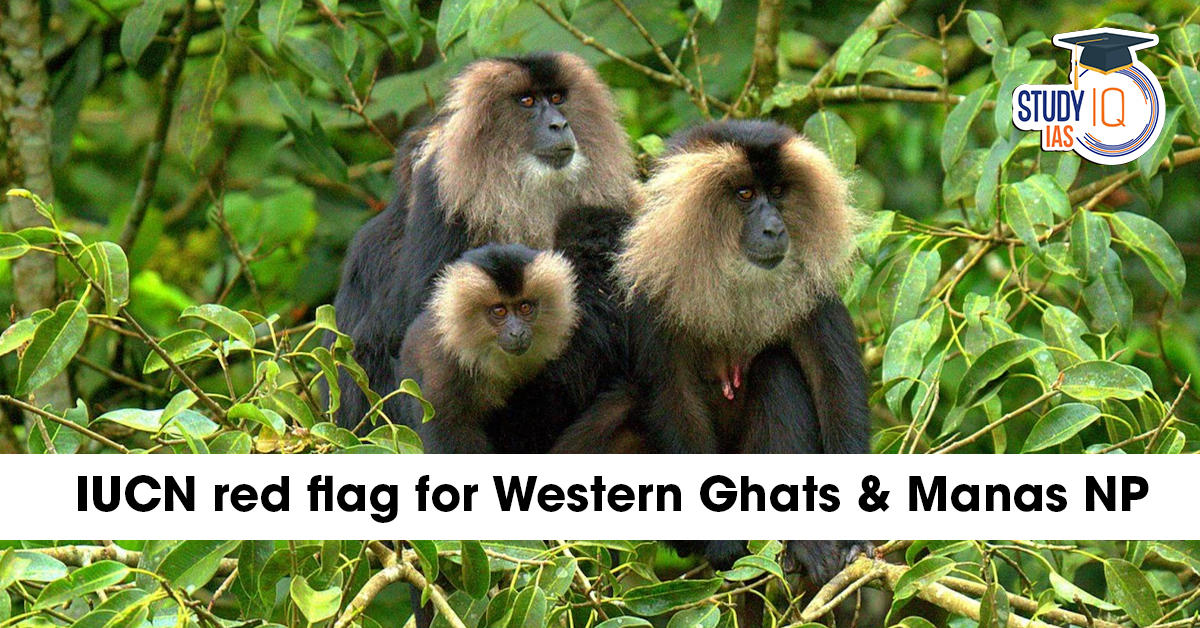Table of Contents
The International Union for Conservation of Nature (IUCN) has issued a red flag for two of India’s most ecologically important World Heritage Sites — the Western Ghats and Manas National Park (Assam) — citing climate change, unregulated tourism, hydropower projects, and habitat degradation as major threats.
In its latest World Heritage Outlook 4 (2025) report, IUCN categorised both these sites as of “significant concern”, highlighting a worrying decline in their ecological health and conservation outlook.
What is the IUCN World Heritage Outlook?
The IUCN World Heritage Outlook is a global assessment program that evaluates all natural and mixed UNESCO World Heritage Sites every 3–5 years.
Objectives:
-
Assess the conservation status of World Heritage sites.
-
Identify pressing threats and recommend corrective measures.
-
Track global progress toward biodiversity targets under the Kunming-Montreal Global Biodiversity Framework (KM-GBF).
The IUCN’s World Heritage Team and the World Commission on Protected Areas (WCPA) jointly implement the initiative, offering independent, science-based data on ecosystem health.
India’s Sites Under “Significant Concern”
According to the report, India’s World Heritage sites show a mixed conservation picture:
“Good”
-
Khangchendzonga National Park (Sikkim)
“Good with Some Concerns”
-
Kaziranga National Park
-
The Great Himalayan National Park
-
Keoladeo National Park
-
Nanda Devi–Valley of Flowers
“Significant Concern”
-
Western Ghats
-
Manas National Park
-
Sundarbans National Park
Western Ghats: A Biodiversity Hotspot Under Stress
Stretching across six Indian states, the Western Ghats is one of the world’s eight “hottest” biodiversity hotspots, home to over 325 globally threatened species, including the Nilgiri tahr, Malabar civet, and Lion-tailed macaque.
Major Threats Identified by IUCN:
-
Hydropower Projects – Projects like the Sillahalla Pumped Storage Project threaten river ecosystems in the Nilgiris.
-
Unregulated Tourism – Waste and vehicular pollution disturb fragile forest corridors.
-
Plantation Expansion – Commercial crops like tea and coffee replace native forests.
-
Invasive Species – Non-native plants such as eucalyptus and acacia disrupt soil and water balance.
-
Climate Change – Species are migrating to higher altitudes due to temperature rise.
The Western Ghats’ fragile ecology faces a delicate balance between development and conservation, requiring urgent attention.
Manas National Park: Conflict Between Conservation & Livelihood
Located in Assam, Manas National Park is a UNESCO World Heritage Site, Project Tiger Reserve, and Biosphere Reserve, known for its population of tigers, pygmy hogs, golden langurs, and wild water buffaloes.
Key Challenges:
-
Encroachment and illegal settlements in buffer zones.
-
Poaching and forest degradation due to weak enforcement.
-
Ethnic conflicts and insurgency in adjoining Bodoland Territorial Region (BTR).
-
Floods from the Manas River causing habitat loss and displacement of wildlife.
Despite government initiatives, the park’s ecosystem health remains fragile, prompting IUCN’s warning.
Global Conservation Trends
The 2025 Outlook reveals that:
-
40% of World Heritage sites face serious conservation threats.
-
Only 57% show a “positive conservation outlook,” down from 63% in previous cycles.
-
Climate change has overtaken hunting as the biggest threat in Asia.
-
Roads, railways, and tourism are emerging as new dangers to biodiversity.
A Call for Coordinated Action
The IUCN urges India and other nations to strengthen their biodiversity policies under the Kunming-Montreal Global Biodiversity Framework (2030).
Recommended Steps:
-
Implement eco-sensitive zoning and sustainable tourism practices.
-
Prioritize community-based forest management.
-
Regulate large infrastructure projects near ecologically sensitive zones.
-
Enhance research and monitoring systems for endemic species.
Conclusion
The IUCN’s red flag for the Western Ghats and Manas National Park serves as a wake-up call for India’s conservation framework.
As climate and human pressures intensify, safeguarding these ecological treasures demands collective action, stronger governance, and grassroots participation.
Protecting India’s natural heritage is not merely an environmental obligation — it’s an ecological responsibility for future generations.


 Municipal Bonds in India: Meaning, Featu...
Municipal Bonds in India: Meaning, Featu...
 Cyclone Montha 2025: Severe Storm Batter...
Cyclone Montha 2025: Severe Storm Batter...
 Kafala System: Meaning, History, Issues,...
Kafala System: Meaning, History, Issues,...




















